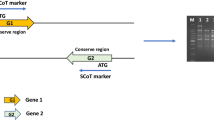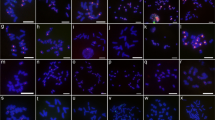Abstract.
The chromosomes (2n = 2x = 24) of Norway spruce are very large since their size reflects the huge amount of genomic DNA (2C = 30 × 109 bp). However, the identification of homologous pairs is hampered by their high degree of similarity at the morphological level. Data so far presented in the literature were not sufficient to solve all the ambiguities in chromosome identification. Several genomic Norway spruce DNA clones containing highly repetitive sequences have been identified and characterised in our laboratory. Three of them were selected for fluorescent in situ hybridization (FISH) experiments because of their strong signals and suitability for chromosome identification: PATR140 hybridized at the centromeric site of three chromosome pairs; PAF1 hybridized in six subtelomeric and two centromeric sites; 1PABCD6 co-localized with the subtelomeric sites identified by PAF1. The statistical analysis of microscopic measurements of chromosomes in combination with the FISH signals of these probes allowed the unambigous construction of Norway spruce karyotype. We also compared the karyotype of Norway spruce with that of other spruce species to infer the number and kind of rearrangements that have occurred during the evolution of these species.






Similar content being viewed by others
References
Arumuganathan K, Martin GB, Telenius H, Tanksley SD, Earle ED (1994) Chromosome 2-specific clones from flow-sorted chromosomes of tomato. Mol Genet Gen 242:551–558
Binelli G, Bucci G (1994) A genetic linkage map of Picea abies Karst based on RAPD markers, as a tool in population genetics. Theor Appl Genet 88:283–288
Brown GR, Amarasinghe V, Kiss G, Carlson JE (1993) Preliminary karyotype and chromosomal localization of ribosomal DNA sites in white spruce using fluorescence in situ hybridization. Genome 36:310–316
Brown GR, Carlson JE (1997) Molecular cytogenetics of the genes encoding 18s-5.8s-26s rRNA and the 5s rRNA in two species of spruce (Picea). Theor Appl Genet 95:1–9
Brown GR, Newton CH, Carlson JE (1998) Organization and distribution of Sau3A tandem repeated DNA sequence in Picea (Pinaceae) species. Genome 41:560–565
Bucci G, Kubisiak TL, Nance WL, Menozzi P (1997) A population 'consensus', partial linkage map of Picea abies Karst based on RAPD markers. Theor Appl Genet 95:643–654
Cheng Z, Presting GG, Buell RC, Wing RA, Jiang J (2001) High-resolution pachytene chromosomes mapping of bacterial artificial chromosomes anchored by genetic markers reveals the centromere location and the distribution of genetic recombination along chromosome 10 of Rice. Genetics 157:1749–1752
Dolezel J, Lysak MA, Kubalakova M, Simkova H, Macas J, Lucretti S (2001) Sorting of plant chromosomes. Methods Cell Biol 64:3–31
Doudrick RL, Heslop-Harrison JS, Nelson CD, Schmidt T, Nance WL, Schwarzacher T (1995) Karyotype of Slash pine (Pinus elliottii var. elliottii) using patterns of fluorescence in situ hybridization and fluorochrome banding. J Hered 86:289–296
Essad S, Arnoux J, Maia N (1966) Controle de validité des caryogrammes: application au caryotype de Lolium perenne L. Chromosoma 20:202–220
Köhler B, Guttenberger H, Borzan Z (1995) Karyotype analysis based on the female gametophyte of Norway spruce. For Genet 2:41–48
Khrustaleva LI, Kik C (2001) Localization of single-copy T-DNA insertion in transgenic shallots (Allium cepa) by using ultra-sensitive FISH with tyramide signal amplification. Plant J 25:699–707
Kubalakova M, Vrana J, Cihalikova J, Lysak MA, Dolezel J (2001) Localisation of DNA sequences on plant chromosomes using PRINS and C-PRINS. Methods Cell Sci 23:71–82
Langer PR, Waldrop AA, Ward DC (1981) Enzymatic synthesis of biotin-labelled polynucleotides: novel nucleic acid affinity probes. Proc Natl Acad Sci USA 78:6633–6637
Lee JH, Arumuganathan K, Kaeppler SM, Kaeppler HF, Papa CM (1996) Cell synchronization and isolation of metaphase chromosomes from maize (Zea mays L.) root tips for flow cytomeric analysis and sorting. Genome 39:697–703
Lubaretz O, Fuchs J, Ahne R, Meister A (1996) Karyotyping of three Pinaceae species via fluorescent in situ hybridization and computer-aided chromosome analysis. Theor Appl Genet 92:411–416
Lysak MA, Cíhalikova J, Kubalakova M, Simkova H, Künzel G, Dolezel J (1999) Flow karyotyping and sorting of mitotic chromosomes of barley (Hordeum vulgare L.). Chrom Res 7:431–444
Mehra P, Khoshoo T (1956) Cytology of conifers. J Genet 54:165–180
Morgante M, Jurman I, Shi L, Zhu T, Keim P, Rafalski JA (1997) The STR120 satellite DNA of soybean: organization, evolution and chromosomal specificity. Chrom Res 5:363–373
Murray BG (1998) Nuclear DNA amount in gymnosperms. Ann Bot 82:3–15
Murray BG, Davies BJ (1996) An improved method for preparing the chromosomes of Pines and other gymnosperms. Biotech Histochem 3:115–117
Ohmido N, Akiyama Y, Fukui K (1998) Physical mapping of unique nucleotide sequences on identified rice chromosomes. Plant Mol Biol 38:1043–1052
Paglia GP, Olivieri AM, Morgante M (1998) Towards second-generation STS (sequenze-tagged sites) linkage maps in conifers: a genetic map of Norway spruce (Picea abies K). Mol Gen Genet 258:466–478
Peterson DG, Lapitan NL, Stack SM (1999) Localization of single- and low-copy sequences on Tomato synaptonemal complex spreads using fluoresence in Situ hybridization (FISH). Genetics 152:427–439
Pinkel D, Straume T, Gray JW (1986) Cytogenetic analysis using quantitative, high sensitivity, fluorescein hybridization. Proc Natl Acad Sci USA 83:2934–2938
Saylor L (1961) A karyotype analysis of selected species of Pinus. Silvae Genet 10:65–96
Schmidt PA (1989) Beitrag zur Systematik und Evolution der Gattung Picea A. Dietr. Flora 182:435–461
Siljak-Yakolev S, Cerbah M, Coulaud J, Stoian V, Brown SC, Zoldos V, Jelenic S, Papes D (2002) Nuclear DNA content, base composition, heterochromatin and rDNA in Picea omorika and Picea abies. Theor Appl Genet 104:505–512
Wambugu J, Kanguha E, Hanotte O, Davis S, Taylor J, Skow L, Brunner R, Schwerin M, Teale A, Iraqi F (2001) Identification of two polymorphic microsatellite repeats on a bovine TNFA-containing BAC clone. Anim Genet 32:105–121
Zhu T, Shi L, Keim P (1995) Fluorescence in situ detection of short single-copy sequences in soybean. Plant Mol Biol Rep 13:270–277
Acknowledgements.
We thank Federica Cattonaro for kindly providing the 1PABCD6 probe. This work was supported by the European Union grant BIO4 CT-972125.
Author information
Authors and Affiliations
Corresponding author
Additional information
Communicated by D.B. Neale
Rights and permissions
About this article
Cite this article
Vischi, M., Jurman, I., Bianchi, G. et al. Karyotype of Norway spruce by multicolor FISH. Theor Appl Genet 107, 591–597 (2003). https://doi.org/10.1007/s00122-003-1306-0
Received:
Accepted:
Published:
Issue Date:
DOI: https://doi.org/10.1007/s00122-003-1306-0




